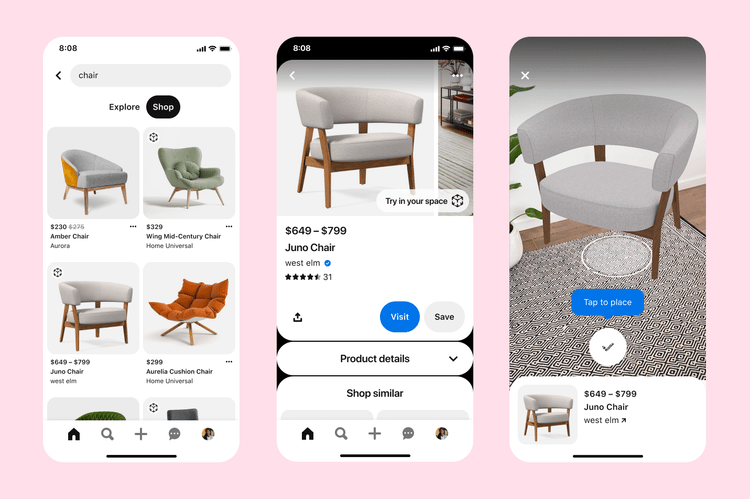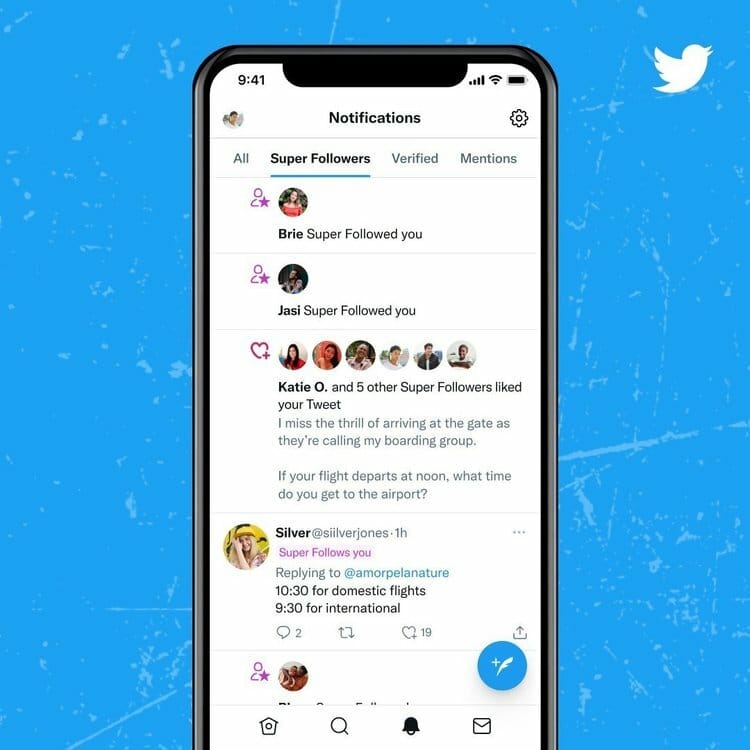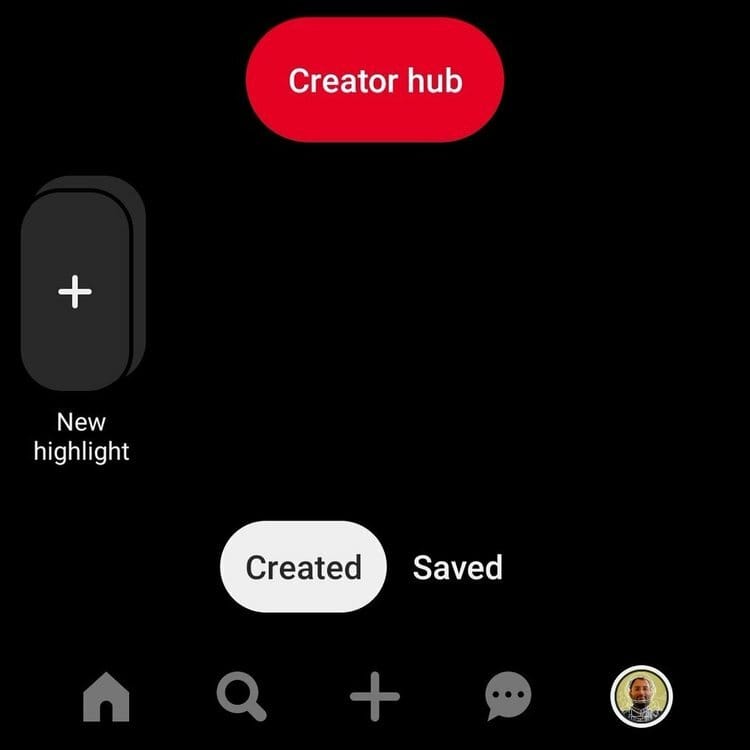Happy Black History Month! Despite only being in the second month of the year, so much has happened on the social media, influencer marketing, and creator economy fronts. I’m expecting February to be just as busy.
This past week, several social media platforms reported their 2021 fiscal earnings, revealing that most of their priorities are creators, short-form video, and shopping. The most notable news was that Facebook lost daily active users (DAU) for the first time in its 18 year history.
Today’s Edition:
Pinterest launches Try On for Home Decor
TikTok introduces a new TikTok Tactics advertising course
Twitter tests an Articles feature for long-form content
Pinterest Expands Its AR Capabilities To Bridge In-Store Shopping Experiences & The Digital World

Pinterest recently launched its latest augmented reality (AR) technology, Try On for Home Decor. The new feature gives Pinners the ability to shop for home decor through augmented reality. Using the Pinterest Lens camera, users can virtually place home decor and furniture items from U.S. retailers like Crate & Barrel, CB2, Walmart, West Elm, and Wayfair in their homes. They can choose the exact colors, sizes, and styles of items they are considering and browse information related to these items such as pricing and reviews.
At launch, Try On for Home Decor is available for more than 80,000 shoppable Pins, marking the platform’s biggest investment in AR technology to date. Previously, Pinterest launched AR Try On for lipstick and eyeshadow.
Pinterest expanding its AR capabilities is the latest sign of platforms and brands leveraging AR and virtual reality (VR) technology to bridge in-store shopping experiences and the digital world. Through immersive experiences like Try On for Home Decor, consumers can discover, try, and purchase products from the convenience of their mobile devices.
Although AR technology has been around for several years, it has yet to become mainstream. However, adoption is increasing due to the pandemic and consumers' increasing comfort with e-commerce. According to eMarketer, half of U.S. adults have either used or are somewhat interested in using AR or VR as of this past fall.
The use of AR seems to have a positive impact on brands as well. Pinterest says that Pinners are 5x more likely to purchase from Try On-enabled Pins than standard Pins. The sales lift that brands receive from AR will be enticing and will encourage brands to seek out platforms and tools that enable consumers to “try before they buy.”
AR also opens up new opportunities for creators. As Pinterest currently allows with Try On for beauty and lipstick, AR can help creators make their content more engaging and actionable, providing their audiences with value.
Based on the gaining popularity of AR, look for Pinterest to expand Try On into other categories to continuously strengthen itself as a destination for discovery, inspiration, and shopping. Predictions for future categories include eyewear, fashion, apparel, hospitality, travel, and even automobiles.
Quick Hits
TikTok introduced TikTok Tactics. The course provides marketers with easy-to-follow instructions on how to use TikTok Ads Manager, the platform’s ad tool. Over four short videos (attribution, targeting and bidding, catalogue, and creative), it breaks down best practices for TikTok advertising.
This short and sweet course provides marketers with an overview and a general understanding of how TikTok advertising works. Even though more specific courses and actual experiments will be needed to develop robust advertising strategies, TikTok Tactics provides enough guidance for marketers to get up and running with TikTok's advertising solutions.

TikTok extended options for the ad authorization period. Creators can now give marketers authorization to turn their content into ads via Spark Ads for as long as 365 days. Ad authorization periods were previously limited to 7, 30, and 60 days.
With more marketers utilizing Spark Ads to increase the ROI of branded content, this type of enhanced flexibility can help marketers drive towards their goals. Often, brands using paid media have the intention of amplifying campaign content for a longer period of time as part of their influencer marketing strategy. With the addition of the 365-day option, they will now be able to do so.
However, the new option does feel like a big jump. Because creators are increasingly limiting paid ads to shorter periods and charging more for usage rights, TikTok should implement additional authorizations, such as 90-day authorizations, to close the gap and provide even more flexibility.

Twitter rolled out new alerts for Super Follows. Creators who use Super Follows, the platform’s subscriber-only content feature, will now be able to see all of their Super Follower interactions via a dedicated section under the Notifications tab.
Similar to Instagram's purple Subscriber Badge, the Super Follows section allows creators to identify subscribing followers in order to prioritize interactions with them over non-paying followers. After a relatively slow start, in which Super Follows generated just $6,000 for creators, it seems to be doing a lot better now.
According to Appfigures, Twitter recently hit half a million for in-app revenue since September, when Super Follows launched. These numbers show that subscriptions can be a viable and sustainable revenue stream for creators and for the platform itself.

Twitter is testing a new Articles feature. According to discovered code, Articles would allow users to share native long-form content, such as a blog post within the app. A spokesperson confirmed that Twitter is “always testing new ways to help people start and engage in conversations” but didn’t share specifics.
Creators already share long-form content on Twitter through threads, screenshots, and Revue, a newsletter platform Twitter acquired last year. Due to the fact that this is already occurring, Twitter’s move to support articles and blogs is a natural progression. Longer form content gives creators the ability to extend their thought-leadership outside of 280 characters, which could help generate more content, leading to more user engagement.

Pinterest is rolling out a new Profile Highlights feature for Idea Pins. The feature enables creators to display as many as six Idea Pins at the top of their profiles. The feature functions similarly to Instagram’s Stories Highlights.
Profile Highlights offers creators new ways to share and highlight their most important content. Though Idea Pins do not disappear like traditional Stories formats, creators can use Profile Highlights to increase visibility and discovery for key content. By surfacing the right content, creators can convert people who come across their profiles into followers.

Snapchat added new Catalog-Powered Shopping Lenses. Brands can now connect Product Catalogs with AR experiences, which allow users to view, try on, and click to purchase multiple products in a single Lens. These AR experiences also provide real-time product information such as pricing, color, and sizes directly from the brand’s product catalogs. Brands also get access to new SKU-level advertising metrics.
Catalog-Powered Shopping Lenses are an upgrade for users and brands, allowing users to seamlessly use AR technology to discover and shop products, while brands can easily connect multiple products to AR experiences. Overall, this continues Snapchat’s significant investments in shoppable AR functionalities.

Chart Of The Week:

Sortlist estimates that people spend more than 36 days on social media each year. YouTube leads the way with users spending over 11 days consuming content on the platform, followed by Facebook (9 days, 18 hours), WhatsApp (9 days, 17 hours), VK (6 days, 23 hours), and then TikTok (6 days, 16 hours).
With more of our lives revolving around social media, it’s likely these numbers will be even higher five years from now.
Upcoming Webinar:
Inclusive Influencer Marketing Panel

Join creators Paul Carozzo and Karneshia Patton, Mavrck's VP of Product Natasha Money Walton, and myself for a fireside-style conversation on inclusive influencer marketing on Wednesday, February 16th. Hosted by Mavrck, we'll discuss the importance of representation in influencer marketing, how brands can make their influencer programs more inclusive, the influencer pay gap, and more. Diversity, inclusion, and representation are some of the most important issues in marketing and advertising today. This is a great opportunity to hear from creators and marketers alike about these topics. Sign up and get more information on the panel here. Even if you can't attend, sign up to get the recording!
What I’m Reading
Snapchat and Facebook agree that the future of social media looks like TikTok (The Verge)
These influencers are quitting Instagram, and they want others to join them (BuzzFeed)
Hollywood agencies are betting big on TikTok talent as they seek to woo Gen Z audiences (CNBC)
Decentraland influencers and lipstick NFTs: The beauty launch party hits the metaverse (Glossy)
‘TikTok is where we see UGC work really hard for us’: Why Bush’s next ad will be creator-made (DigiDay)
